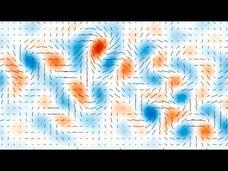National Institute of Standards and Technology
Screaming Photons
Students from the Alexander Dawson School in Boulder, Colorado explain the workings of a "dark detector" coated with the one of the world's darkest materials, a forest of carbon nanotubes that reflect almost no light across the visible...
Professor Dave Explains
Quantum Electrodynamics (QED)
In our study of physics, we have become aware of four forces, and the fields that mediate them. Once we got deep into quantum theory, we started to realize that these forces are not mediated by fields at all, but rather by quanta. That's...
Professor Dave Explains
Quantization of Energy Part 2: Photons, Electrons, and Wave-Particle Duality
So Max Planck kicked things off, but how does the story of modern physics continue? With none other than your favorite scientist and mine, Albert Einstein! He did more than just stick his tongue out and have crazy hair. He elucidated the...
Next Animation Studio
Why the Moon has a tail
Scientists have known that the Moon has a tail, like a comet, since the late 1990s, but now they know where it comes from — and why it’s brighter sometimes than others.
Physics Girl
How does laser cooling work?
Lasers are known to burn things, fix eyes, and dance on powerpoint presentations. But they can also be used to cool objects to some of the coldest temperatures in the universe.
Physics Girl
The ULTRAVIOLET CATASTROPHE
How did the field of quantum mechanics come about in the first place? The Rayleigh-Jeans catastrophe, also known as the ultraviolet catastrophe was a prediction by the Rayleigh-Jeans law that a blackbody would radiate infinite amounts of...
Next Animation Studio
Laser propulsion: NASA's laser-powered spacecraft will fly to Mars in 72 hours
NASA scientist Philip Lubin is working on perfecting laser technology that could propel a light spacecraft to Mars in as little as three days. In order for spacecraft to achieve faster speeds, Lubin proposes using an electromagnetic...
Astrum
What happens as you approach the speed of light?
As you go faster, what happens to time and space? What would happen if you could manage to go the speed of light? Astrum Answers!
Curated Video
Mirrors: the Science of Reflection
This video provides a simple and concise explanation of how mirrors work. It covers the history of mirrors, from primitive stones to modern glass coated with a thin layer of metal. The video explains the concept of reflection and how...
Professor Dave Explains
Widefield and Confocal Fluorescence Microscopy
We just learned about electron microscopy, so what was the next major innovation in microscopy in the 20th century? That would be fluorescence microscopy, of both the widefield and confocal varieties. How does this work? What is...
Visual Learning Systems
The Nature of Light: Nature of Electromagnetic Waves
Students will learn about the different frequencies along the electromagnetic spectrum. Vivid animation is used to explore the visible spectrum of light and the colors it allows us to see everyday. The video also investigates various...
Ancient Lights Media
Photosynthesis: The Light-Dependent Reactions
Plant Physiology and Chemistry Set: 2. This clip provides an in-depth look at the details of the light-dependent Biochemical reactions of photosynthesis,
Curated Video
Using nanomaterials to make solar panels more efficient
AP Television
Boston, Nov. 5, 2010
1. General shots Boston skyline
2. Various solar panels on roof of MIT library
3. Wide shot entrance to MIT Building 66
AP Television
Boston, Nov. 3, 2010
4. Zoom in sign for MIT Institute for Soldier...
Sky News
UK PM Boris Johnson visits training facility in County Durham
CLEAN: Shows interior shots UK Prime Minister Boris Johnson MP meeting students and teachers at a training facility in County Durham on 27th May, 2022 in Durham, England, United Kingdom
Howard Hughes Medical Institute
Coral Bleaching
What is coral bleaching? Tackle a trendy topic with a narrated animation. Through a combination of video and illustration, the narrator introduces viewers to a coral reef, then goes inside a coral polyp to show its symbiotic relationship...
Scholastic
Study Jams! Light
Let there be light in your classroom with a video that explains that light travels in waves, the electromagnetic spectrum contains seven colors, and the color of an object depends on which light waves it reflects and absorbs. With...
Curated OER
Photosynthesis: Light Reactions
This clip picks up right where the Khan Academy's Photosynthesis video left off. Chemicals such as hydrogen and compounds such as NADPH are reviewed along with details including the stroma, thylakoid, lumen, and grana. See the parts of a...
TED-Ed
What Makes Neon Signs Glow? A 360° Animation
Why are neon signs so bright and colorful? Scholars discover how artists create neon signs and find out that neon is not the only gas they use in their production. Next, they explore the history of neon signs and how their development...
SciShow
The Hunt for the First Neutrinos in the Universe
How far back in time can scientists see? Currently, the earliest photo of the universe is the cosmic microwave background, but math models prove the universe existed long before that time. An installment from the SciShow Space series...
PBS
The Electromagnetic Spectrum
What can the electromagnetic spectrum tell us about the sun? As it turns out, quite a bit! See the sun in a whole new light with a video from NOVA's Sun Lab unit. The narrator describes the electromagnetic spectrum in terms of visible...
PBS
The Anatomy of the Sun
Welcome to Sun 101! What better way to gain an understanding of our star than to learn about its anatomy? Physical science scholars peer inside to discover the inner workings of the sun through a video and discussion questions. The...
Physics Girl
This Crystal Can Split Light Particles
Can photons be split? It appears that way! Observe as one photon becomes two during a video from an informative physics playlist. The resource examines the nature of photons, how the crystals can help increase or decrease the number of...
Veritasium
Gravitational Wave Discovery! Evidence of Cosmic Inflation
Can scientists take a picture of the universe before the planets formed? Using telescopes and new technology, scientists take more detailed photos every few years. Cosmic inflation challenges our understanding of the early universe.
PBS
The True Nature of Matter and Mass
Scientists know mass is energy, but what is energy? An engaging Space Time video delves into the topic as part of its The Origin of Matter and Time playlist. From quarks and gluons with no mass to the gravitational effect, the true...









